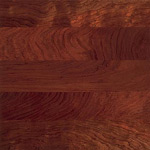Serving Upstate NY—VT—MA • For selections & prices, CALL or EMAIL US
Bubinga
Wood Flooring Species
Scientific Name:
Guibourtia demeusei
Other Names and Species:
African Rosewood
Akume
Buvenga
Ebana
Essingang
Kevazingo
Kewazingo
Okweni
Ovang
Waka
Origin:
Central Africa
Appearance:
A beautiful, dense hardwood with a lustrous appearance, bubinga has a rose-colored background with darker purple striping. This wood is usually very uniform in graining and color, and the texture is fine and even. When quarter-sawn, the figure of bubinga shows considerable “flame,” while it exhibits attractive rosewood graining when flat-sawn. When fully aged, bubinga has a rich burgundy red color.
Properties:
Bubinga is a moderatly durable wood. The sapwood is more permeable than the heartwood and so is less resistant to preservative treatment. It is resistant to termite attack.
Janka Hardness: 1980
Bubinga is a hard and durable wood flooring species. It is ninety-eight percent harder than teak, about fifty-three percent harder than hard maple, roughly fourteen percent harder than African padauk, a little over eight percent harder than hickory or pecan, almost identical in hardness to jarrah (under one percent), and ninety percent as hard as santos mahogany’s ranking of 2200.
Workability:
Although bubinga works easily with hand or power tools, it can sometimes be difficult to glue because of gum pockets. For nailing, it is recommended that holes be pre-drilled. This wood stains easily and has excellent finishing properties. Care should be taken when sanding, as contact with the wood dust has been known to cause mild dermatitis.
Principal Uses:
Commonly found as a veneer for cabinetwork, furniture, paneling, knife handles, and fancy goods, bubinga is also used for wood flooring and inlays wherever fine graining and a rich reddish color are desired.
Learn more about available grades of
Bubinga hardwood flooring »





